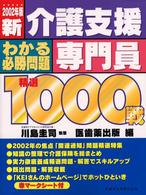- ホーム
- > 洋書
- > 英文書
- > Science / Mathematics
Full Description
Drawing on state-of-the-art research results, Resistance Welding: Fundamentals and Applications, Second Edition systematically presents fundamental aspects of important processes in resistance welding and discusses their implications on real-world welding applications. This updated edition describes progress made in resistance welding research and practice since the publication of the first edition.
New to the Second Edition:
Significant addition of the metallurgical aspects of materials involved in resistance welding, such as steels, aluminum and magnesium alloys, zinc, and copper
Electric current waveforms commonly used in resistance welding, including single-phase AC, single-phase DC, three-phase DC, and MFDC
Magnesium welding in terms of cracking and expulsion
The effect of individual welding parameters
2-D and 3-D lobe diagrams
New materials for the ultrasonic evaluation of welds, including A-scan, B-scan, and in-line A-scan
The book begins with chapters on the metallurgical processes in resistance spot welding, the basics of welding schedule selection, and cracking in the nugget and heat-affected zone of alloys. The next several chapters discuss commonly conducted mechanical tests, the monitoring and control of a welding process, and the destructive and nondestructive evaluation of weld quality. The authors then analyze the mechanisms of expulsion—a process largely responsible for defect formation and other unwanted features—and explore an often overlooked topic in resistance welding-related research: the influence of mechanical aspects of welding machines. The final chapters explain how to numerically simulate a resistance welding process and apply statistical design and analysis approaches to welding research.
To obtain a broad understanding of this area, readers previously had to scour large quantities of research on resistance welding and essential related subjects, such as statistical analysis. This book collects the necessary information in one source for students, researchers, and practitioners in the sheet metal industry. It thoroughly reviews state-of-the-art results in resistance welding research and gives you a solid foundation for solving practical problems in a scientific and systematic manner.
Contents
Welding Metallurgy. Electrothermal Processes of Welding. Weld Discontinuities. Mechanical Testing. Resistance Welding Process Monitoring and Control. Weld Quality and Inspection. Expulsion in Resistance Spot Welding. Influence of Mechanical Characteristics of Welding Machines. Numerical Simulation in Resistance Spot Welding. Statistical Design, Analysis, and Inference in Resistance Welding Research. Index.








